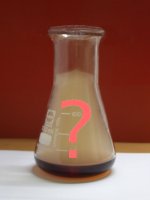


Riddle: A copper (I) / copper (II) mixed oxidation state complex
This page gives a set of experiments, which all show that copper is capable of forming a mixed oxidation state complex. Formation of this complex requires the presence of the following:
- Copper (I) in solution
- Copper (II) in solution
- Chloride at high concentration in solution
It is known very well - and described at many places - that copper is capable of forming many complexes. Plain aqueous copper (II) is sky-blue. In the presence of chloride, coordination complexes all up to CuCl42¯ are formed, with colors ranging from green to yellow/brown. Plain aqueous copper (I) ions do not exist. In the presence of chloride, colorless CuCl2¯ is formed.
The experiments, described here, however, show that when solutions with CuCl2¯ and with CuCl42¯ are mixed, then a new intensely colored compound is formed. The only acceptable explanation for all observations is the formation of a new compound, which has copper (I), copper (II) and chloride as its constituents. The experiments give strong evidence for this explanation. No other acceptable explanation can be given.
Most remarkable is not what the experiments show, but the fact that virtually nowhere in literature a description is given of the dark compound, or mention is made of a mixed oxidation state complex of copper. On the other hand, one can hardly imagine that the quite remarkable reaction, demonstrated here in many different ways, is not observed by others.
The dark complex only is stable in very concentrated solutions with chloride. Acid is not needed for the complex, concentrated solutions of NaCl also support the formation of the complex. On dilution with water, the complex decomposes and the color of the green copper (II) / chloride complex appears. On further dilution only plain blue aqueous copper (II) can be observed.
![]()
The equipment, safety precautions and way of disposal are the same for all experiments, described in the links below. For each individual experiment the set of required chemicals is given.
![]() Required
equipment:
Required
equipment:
-
test tubes
-
stoppers
-
erlenmeyer or little transparent bottle of approximately 100 ml
![]() Safety:
Safety:
- Copper and its compounds are moderately toxic.
- Hydrochloric acid is corrosive.
- The fumes of concentrated hydrochloric are very irritating and should not be inhaled.
- In one of the experiments sodium hydroxide is used. This is very caustic. Especially the eyes should be well-protected against splashes of solutions of sodium hydroxide! When sodium hydroxide is dissolved in water, quite some heat is produced. Adding a lot of sodium hydroxide to a small volume of water may result in boiling and splattering of the solution!
![]() Disposal:
Disposal:
-
Copper compounds are moderately toxic for the environment. It is best to bring copper waste to a chemical waste processing facility. Only if very small amounts of copper salts are used, the waste may be flushed down the drain with lots of water.
![]()
Different experiments, showing the mixed valency complex
Five experiments are given below, each of them showing the formation of a dark brown compound. The experiments in themselves already are very nice and remarkable experiments, that's why all experiments on copper chemistry are placed here. It is remarkable what can be done with such well-known chemicals, as used in the experiments, given below.